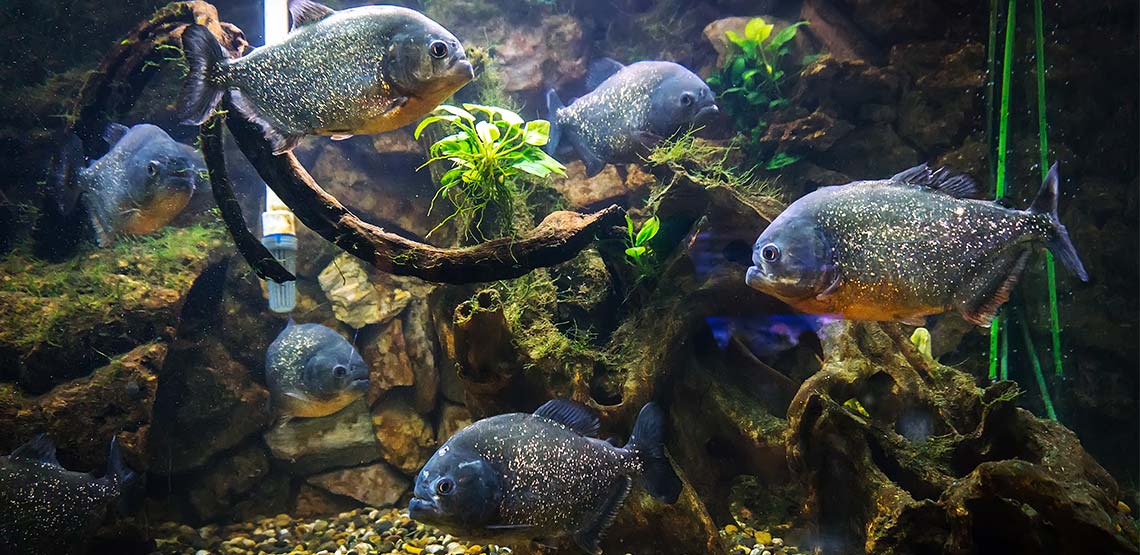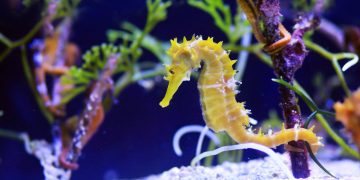A Complete Piranha Resource
Though they have gained a bloodthirsty reputation for loving meat, piranhas are actually omnivorous fish originating from freshwater rivers in South America. While their sharp, tightly interlocking teeth strike fear in many swimmers, piranhas rarely pose a significant risk to humans and are growing in popularity as aquarium pets in places where they are legal.
Appearance
Size: Most piranha fish reach a length of 6 to 10 inches when fully grown, though some wild piranhas reach lengths as long as 3 feet (18 inches). They have eye-shaped bodies, but some piranha fish have a bloated appearance that makes them appear more circular than ovular.
Color: Most piranhas have silver scales with orange undersides. Under certain lighting conditions, the scales of a piranha may actually appear to glitter or reflect light.
Variants: One popular pet variant is the black piranha, which has dark gray rather than silvery scales and piercing, bright-red eyes. Its cousin, the red belly piranha, features traditional scale colors but has a scarlet rather than an orange underside.
Behavioral Characteristics
While the piranha's aggressive reputation is not wholly deserved, these fish should not be kept in the same tank as other fish species. However, some more placid individual fish may get along well with other small fish, provided they are well fed and will not consider your other pets a snack. During their early lives, piranhas tend to be school fish, so young piranhas should be kept with other piranha fish. As they mature, though, most piranhas become solitary.
You May Also Like:
Related Search Topics (Ads):
Health and Care
Feeding: It's important to remember that these fish are omnivores; while they need (and love) meat, they must eat a varied diet to meet their nutritional requirements. Fresh or frozen worms are a favorite, and you will find plenty of freeze-dried options at your local pet store. The occasional chunk of fresh beef or chicken makes a tasty treat, but what is most important is to include raw vegetables as part of your fish's regular diet. Zucchini, spinach and chunks of uncooked potato make excellent choices. Feeding your piranha goldfish can lead to intestinal and systemic diseases and is not recommended.
Tank Care: Piranhas are messy fish, producing significant amounts of waste. You'll have to invest in a quality aquarium filter and change 10% to 15% of the water in the tank each week. Experts recommend freshwater aquariums with a volume of at least 2 gallons per inch of fish size, per fish. Thus, an 8-inch fish needs 16 gallons of water; a pair of 10-inch fish would need a 40-gallon tank. Water should be kept in the range of 76F to 83F.
Health Concerns: Pathogen-based illnesses are the greatest cause for concern. You can help your piranhas by disinfecting the tank thoroughly before introducing them to it. Common symptoms of bacterial, fungal and parasitic infections include a reduction in energy, discoloration, difficulty swimming, scale bleeding and lesions. Act quickly if you spot any symptoms to give your fish the best chance of survival.
Life Expectancy: Well-kept fish can survive for 10 years or longer.
Finding Piranhas for Sale
Piranhas are illegal in a number of U.S. states. If you find piranhas for sale in Alabama, Alaska, Arizona, Arkansas, California, Colorado, Florida, Georgia, Hawaii, Kentucky, Louisiana, Maine, Massachusetts, Mississippi, Nevada, New Mexico, New York, North Carolina, Oklahoma, South Carolina, Texas, Utah, Virginia or Washington, do not purchase them – you will be violating the law.
If you live in a state, country or jurisdiction where the sale of piranhas is legal, expect a steep price tag. A single red belly piranha can run as much as $500.
Types of Piranhas to Own
There are different types of piranhas in the world, and certain types make for better aquarium pets:
- Red Bellied Piranha
- Black Piranha
- Ruby Red Piranha
Keep in Mind
If you have never had a pet before or owned a fish, a piranha may not be the best choice for you, as they require an aquarium setup and make a lot of mess. Aquariums demand a lot of upkeep. Not only do you need to make sure the water is at balanced levels, but even with a filter you need to make sure the decorations are cleaned on a monthly basis.
If you are a first-time fish owner, look for a beta fish. These are known as one of the most simple fish to take care of because they do not produce an abundance of waste and they do not need a fancy aquarium setup. They do well in fresh water bowls or tanks. Of course, make sure they have room to swim around and do not put them in a tank with another beta fish.

